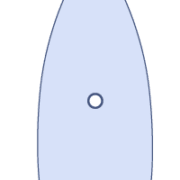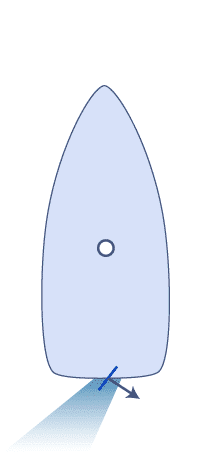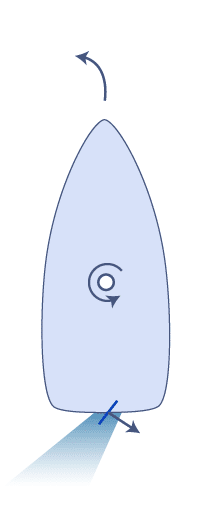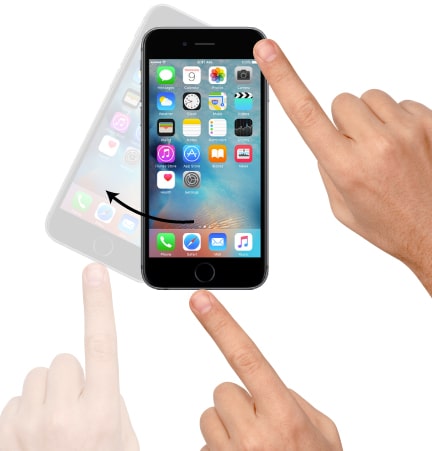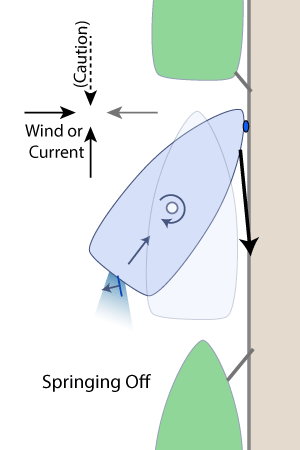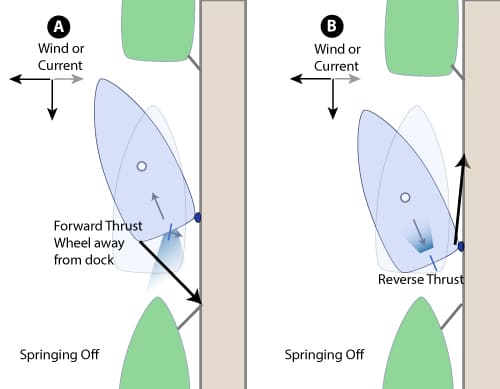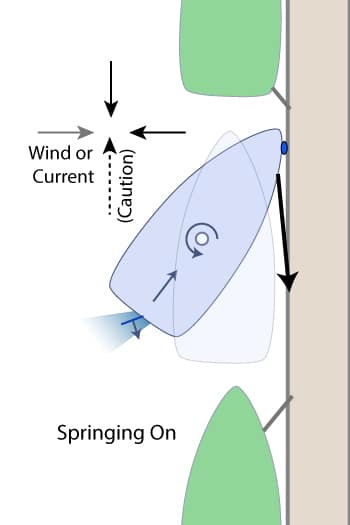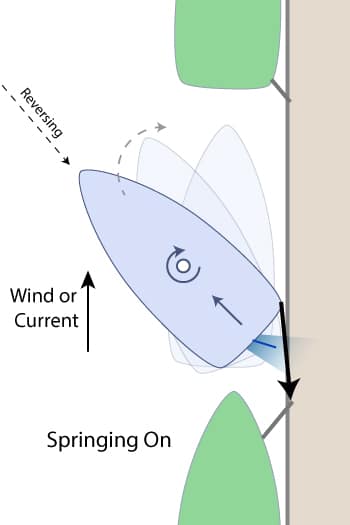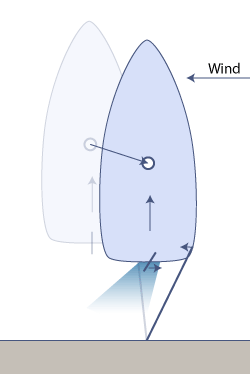Using Spring Lines for Docking
A spring line is just a dockline that is placed strategically from the boat to the dock to help maneuver and turn the boat in place – get it safely into the dock or safely away. Using spring lines is a force/direction/distance equation. When forces act in different directions at a distance apart, the combination creates a turning “moment”. The word moment is not a “moment in time” it is a technical word for this combination of force/direction/distance – and it just means that the boat wants to turn. Knowing how to use spring lines means that you control the boat at the dock, not the wind, not the current.
First, understand the dynamics of the water thrust from the propeller to the rudder. The propeller pushes water backward over the rudder, whereas the rudder directs the flow direction of the water. Thus the rudder changes the direction of the water flow by applying a force to the water flow. To balance the universe and make sure we all don’t just spin off into space, the water pushes back on the rudder in an equal amount in the opposite direction.
|
When thrust from a propeller is applied to a turned rudder a force is generated.
|
The result of which turns the boat and moves it forward.
|
Thrust over the Rudder
Knowing this, you will use your understanding of turning moments with the rudder when using spring lines. When you place a spring line into the equation, you are adding a new force, in a new direction, at a distance from the water force on the rudder – allowing you to effectively turn the boat.
Right now, pull out your phone, place it on your desk, and do this exercise.
iPhone Spring and Moment
Hold the top right corner down with a finger then push the bottom middle of the phone in the direction shown. You will see the phone turn. It’s kinda obvious when you do this but, needless to say, this is how you can apply this process to your boat to get you into and out of some really tight places.
When springing on and off docks, we apply this directional force of water on the rudder at the center stern of the boat and combine it with force from a dock line at a cleat near the front of the boat to create a large turning moment. The magnitude of the turning moment is equal to the force multiplied by the perpendicular distance between the forces. Remember the seesaw? A lighter person on a long plank can lift a heavier person on a short plank. That is “moment” – force x distance.
Thus, each spring maneuver is purposefully designed to understand the placement and direction of forces. In many cases, you don’t need to spring on or off. In those cases, the wind or current is helping you get into the dock or away from it. Thus you only need spring on or spring off when the wind or current is not being your friend today.
Below we show some common scenarios you will encounter and how to use a spring line to your advantage. In the Maneuvering Under Power course, we dive into this topic much deeper.
Spring the Aft Out from a Tee Head
Use this method below in any wind direction except a wind from forward. If the wind is coming from forward, the wind could push your bow down into the behind boat before you gain enough speed in reverse to get out and away.
To do this maneuver, place a spring line on a forward dockside cleat and run it aft to the dock. Use a fender to protect the bow against the dock. Turn the wheel into the dock and apply forward thrust. The aft of the boat will turn out. Once the angle is clear of other boats, engage reverse. It will work well for you to make the angle to the dock with your boat larger than you think – in doing this you will gain more time.
Springing Off a Tee Head
Spring the Bow Out from a Tee Head
Use these when winds are not coming from behind otherwise your bow can get pushed into the boat ahead. But if you must, make sure your boat is pointing more than 45 degrees out from the dock to ensure you clear the forward boat once you release the dock lines.
Using forward: See scenario A below. Place a spring line on the non-dockside aft cleat and run it aft behind the stern of boat to the dock. Turn the wheel away from the dock and apply forward thrust. The aft quarter of the boat will be heavily squashed into the dock, so make sure you use a fender or two. The bow will turn out. Once the angle is clear of other boats, release the spring line and go.
Using reverse: See scenario B below. This is less effective than A because you don’t have the advantage of prop wash on the rudder. Place a spring line on the dockside aft cleat and run it forward to the dock. Center the wheel and apply reverse thrust. The aft quarter of the boat will be squashed into the dock, so make sure you use a fender. The bow will turn out. Once the angle is clear of other boats, release the spring line. And engage forward thrust.
TIP: Make sure that the spring line has no knots or twists so that it can run smoothly and clear of the cleats when releasing. A last-minute tangle can be disastrous. Monitor your crew’s ability to perform this properly.
Spring Lines
Spring onto a Tee Head
Come in at a fairly high angle with a dock line ready on the forward dock side cleat. Have a crew member cleat the dock line aftwards to the dock. Turn the wheel away from the dock and apply forward thrust. The stern will move in toward the dock. Take care when doing this maneuver downwind. You would be better off pointing the boat into the wind.
Springing the Stern onto a Tee Head
You could also back upwind placing the stern into the dock and then spring the bow around. Perform this by having a dock line cleated to the dockside aft cleat. Run the dock line aftwards to the dock. Turn the wheel into the dock and apply forward thrust. Only do this method when backing upwind – the reason being that the turning moment is reduced because the distance between the thrust force and the dock line force is small. Only use a little rudder force and go slow. The current of wind is helping you anyway so patience here will serve you.
Springing the Bow into a Tee Head
Springing Out of a Slip
Most of the time it is easy to get out of a slip except when the wind is working against your turn into a tight slipway.
Use some newfound turning moment knowledge to guess which spring line is the more appropriate. Click on the one you guess.
Springing Out of a Slip
Spring Your Boat to Windward
Here is a neat trick to use when in a Mediterranean mooring situation with your boat stern to the dock. Many times, you want your boat to move sideways to windward. Simply turn your wheel downwind and apply forward thrust. The thrust on the rudder pushes the boat to windward. The aft or midship spring line prevents the boat from moving forward.
Spring Your Boat Upwind
Maneuvering and Docking Experience
FarmboyI grew up on a sheep farm in New Zealand. My dad had me driving the Land Rover by the time I was four. He’d set the hand throttle and all I had to do was steer the truck around the paddock while he jumped off, ran back to the trailer, and tossed out hay to the sheep. My instructions were to not hit water troughs, trees, or fences. By nine, I could back the trailer through six inches of mud into the hay shed. It’s all about experience. |
In sailing, the wind is your friend, but too much wind can quickly become your nightmare. Maneuvering your boat under power in the marina is similar. Albeit, zero wind is your BFF (best friend forever—haa, now you know what your daughter’s acronym means).
It is important, then, that you become an expert at maneuvering in all wind conditions and directions. In the NauticEd’s Maneuver and Dock Your Sailboat Under Power book, we provide you with a comprehensive set of exercises that lead you through every docking scenario: side, stern, and forward winds, going backward and forward into slips and Tee heads, using spring lines, and Mediterranean mooring situations. We highly recommend that book.


